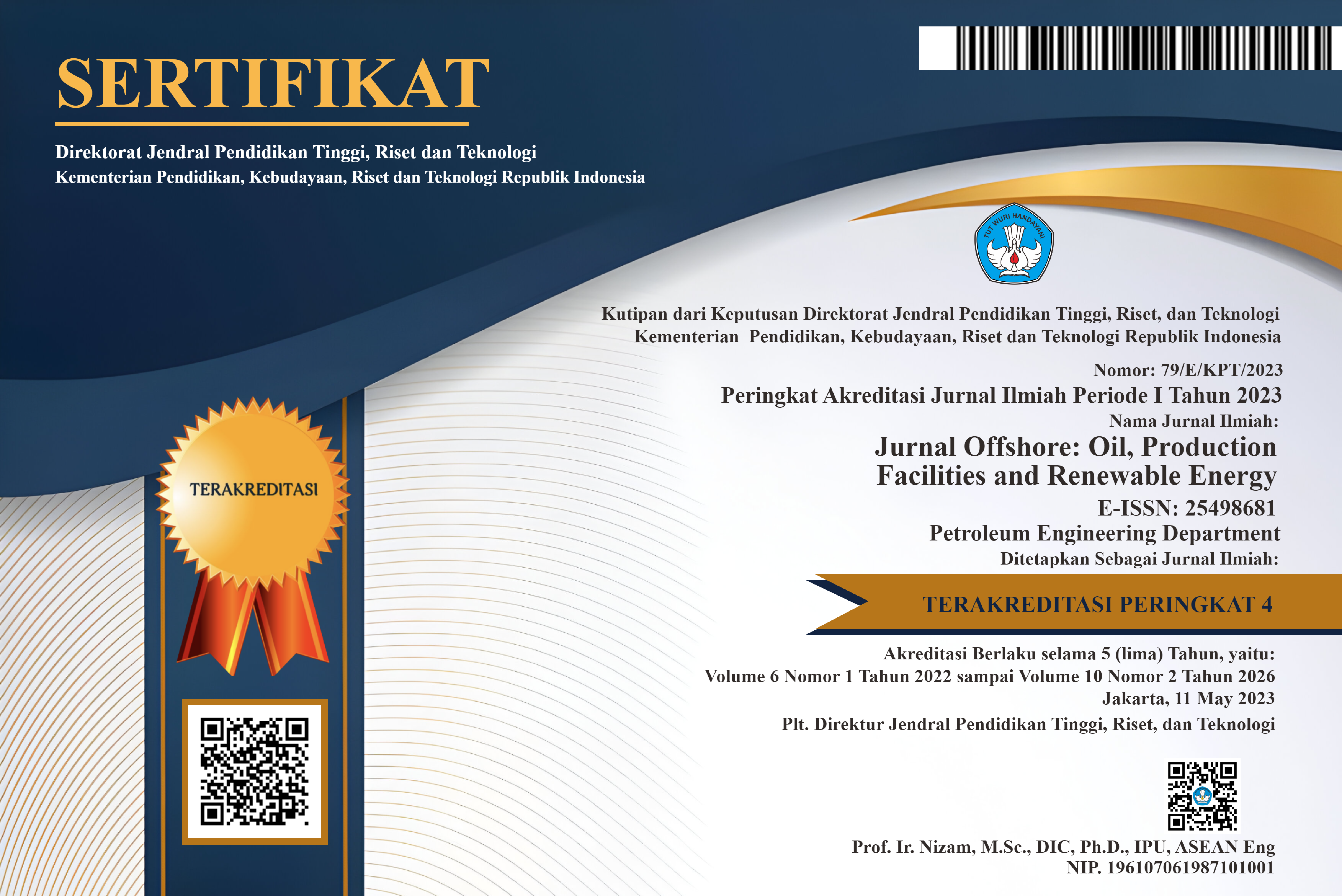Potensi Panas Bumi Gedongsongo Lereng Selatan Gunung Ungaran Jawa Tengah Berdasarkan Analisis Geosains
DOI:
https://doi.org/10.30588/jo.v2i1.354Keywords:
panas bumi, gunung ungaran, analisis geosains, geothermal, mount ungaran, geoscience analysisAbstract
Kajian tentang potensi energi panas bumi dan rekomendasi pemanfaatanya telah dilakukan di Gunung Ungaran Jawa Tengah area lokasi candi Gedongsongo. Penelitian bertujuan untuk memperkirakan potensi energi panas bumi lereng selatan Gunung Ungaran, serta membuat skema pemanfaatan energi listrik panas bumi sebagai rekomendasi untuk digunakan di daerah tersebut. Beberapa hasil penelitian yang telah dilakukan pada bidang geofisika, geologi dan geokimia di Gedongsongo lereng selatan Gunung Ungaran, didapatkan bahwa daerah tersebut merupakan daerah prospek panas bumi. Hasil penelitian geofisika dengan metode magnetik didapatkan pengontrol manifestasi panas bumi berupa sesar pada kedalaman 1050 meter – 1100 meter. Suhu reservoir yang diperoleh sebesar 230 oC, dimana masuk dalam kategori syarat potensi energi panas bumi. Hasil konversi energi panas bumi ke listrik sebesar 15 % dari besarnya daya listrik per satuan luas adalah 2,25 MWe. Perkiraan luas prospek panas bumi Gunung Ungaran adalah 1 km2 maka daya listrik yang dapat dimanfaatkan adalah 2,25 MWe. Jika di konversi, jumlah daya listrik sebesar 2,25 MWe dapat menerangi rumah sebanyak 2500 rumah jika setiap rumahnya mempunyai daya 900 Watt.
Studies on the potential of geothermal energy and recommendations for its use have been carried out at Mount Ungaran, Central Java, the location of the Gedongsongo temple. The research aims to estimate the potential for geothermal energy at the southern slope of Mount Ungaran, as well as making a scheme for the utilization of geothermal electricity as a recommendation for use in the area. Some of the results of research conducted in the fields of geophysics, geology and geochemistry at Gedongsongo on the southern slope of Mount Ungaran, found that the area is a geothermal prospect area. The results of geophysical research using the magnetic method show that the controller of geothermal manifestations is faults at depths of 1050 meters - 1100 meters. The reservoir temperature obtained is 230 oC, which is included in the category of geothermal energy potential requirements. The result of the conversion of geothermal energy to electricity by 15% of the amount of electricity per unit area is 2.25 MWe. The estimated area of Mount Ungaran's geothermal prospect is 1 km2, the electric power that can be utilized is 2.25 MWe. If converted, the amount of electric power of 2.25 MWe can illuminate 2500 homes if each house has 900 Watt power.
References
Bemmelen, R.W., van, 1970, The Geology of Indonesia, Vol. IA, General Geologi of Indonesia and Adjacent Archipelagoes Second Edition, Government publisher, The Hague, Netherlands.
Brooks, J.A., 1966. Geomagnetism as the Earth’s Mantle ( A Review), M. Sc Thesis, Dept. Of Geology, University of Tasmania.
Rezky, Y., Zarkasyi, A. dan Risdianto, D., 2012. Geothermal System & Conceptual Model Of Gunung Ungaran Geothermal Area, Central Java, Buletin Sumber Daya Geologi Volume 7 Nomor 3, Pusat Sumber Daya Geologi, Bandung
Suhartono, N., 2012, Pola Sistim Panas dan Jenis Geothermal Dalam Estimasi Cadangan Daerah Kamojang, Jurnal Ilmiah MTG, Vol. 5 (2)
SNI, 1999, Metode Estimasi Potensi Energi Panas Bumi, Dirjen Geologi dan Sumber Daya Mineral, SNI 13-6171-1999
Sulaiman, 1994. Perumusan Variasi Harian Medan Magnet Bumi Berdasarkan Teori Magetohidrodinamika, Skripi, ITB, Bandung.
Telford, W.M., Geldart, L.P., Sheriff, R.E. , and Keys.D.A., 1990, Applied Geophysics, Cambridge University Press.New York.
Thanden, R.E., Sumadirdja, H., Richards, P.W dan Sutisna, K., Amin, T.C., 1996, Peta Geologi Lembar Magelang dan Semarang, Jawa, Pusat Penelitian dan Pengembangan Geologi, Bandung
Wahyudi, 2005. Kajian Potensi Panas Bumi Dan Rekomendasi Pemanfaatannya Pada Daerah Prospek Gunungapi Ungaran Jawa Tengah, Jurusan Fisika, FMIPA-UGM, Yogyakarta
Downloads
Published
How to Cite
Issue
Section
License
Authors retain copyright and grant the Jurnal Offshore right of first publication with the work simultaneously licensed under a Creative Commons Attribution 4.0 International License that allows others to share (copy and redistribute the material in any medium or format) and adapt (remix, transform, and build upon the material) the work for any purpose, even commercially with an acknowledgement of the work's authorship and initial publication in Jurnal Offshore. Authors are able to enter into separate, additional contractual arrangements for the non-exclusive distribution of the journal's published version of the work (e.g., post it to an institutional repository or publish it in a book), with an acknowledgement of its initial publication in Jurnal Offshore. Authors are permitted and encouraged to post their work online (e.g., in institutional repositories or on their website) prior to and during the submission process, as it can lead to productive exchanges, as well as earlier and greater citation of published work (See The Effect of Open Access).















